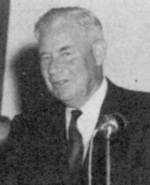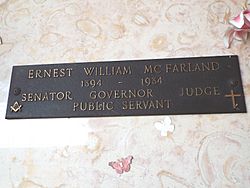Ernest McFarland facts for kids
Quick facts for kids
Ernest McFarland
|
|
|---|---|

McFarland c. 1955
|
|
| Chief Justice of the Arizona Supreme Court | |
| In office January 1, 1968 – December 31, 1968 |
|
| Preceded by | Charles C. Bernstein |
| Succeeded by | Jesse Addison Udall |
| Justice of the Arizona Supreme Court | |
| In office January 4, 1965 – January 4, 1971 |
|
| Preceded by | Edward W. Scruggs |
| Succeeded by | James Duke Cameron |
| 10th Governor of Arizona | |
| In office January 3, 1955 – January 5, 1959 |
|
| Preceded by | John Howard Pyle |
| Succeeded by | Paul Fannin |
| Senate Majority Leader | |
| In office January 3, 1951 – January 3, 1953 |
|
| Deputy | Lyndon B. Johnson |
| Preceded by | Scott W. Lucas |
| Succeeded by | Robert A. Taft |
| Chairman of the Senate Democratic Caucus | |
| In office January 3, 1951 – January 3, 1953 |
|
| Preceded by | Scott W. Lucas |
| Succeeded by | Lyndon B. Johnson |
| United States Senator from Arizona |
|
| In office January 3, 1941 – January 3, 1953 |
|
| Preceded by | Henry F. Ashurst |
| Succeeded by | Barry Goldwater |
| Personal details | |
| Born |
Ernest William McFarland
October 9, 1894 Earlsboro, Oklahoma, U.S. |
| Died | June 8, 1984 (aged 89) Phoenix, Arizona, U.S. |
| Resting place | Greenwood/Memory Lawn Mortuary & Cemetery Phoenix, Arizona |
| Political party | Democratic |
| Spouses |
Clare Collins
(m. 1926; died 1930)Eveland Smith
(m. 1939) |
| Education | East Central University University of Oklahoma (BA) Stanford University (JD, MA) |
| Military service | |
| Allegiance | |
| Branch/service | |
| Years of service | 1917–1919 |
| Battles/wars | World War I |
Ernest William McFarland (born October 9, 1894 – died June 8, 1984) was an important American leader. He was a Democrat. He worked in all three parts of the government: as a judge, a governor, and a senator. He is also known as one of the "Fathers of the G.I. Bill," which helped soldiers after World War II.
McFarland was a U.S. senator for Arizona from 1941 to 1953. He even became the Senate Majority Leader from 1951 to 1953. Later, he was the tenth governor of Arizona from 1955 to 1959. Finally, he served as the chief judge on the Arizona Supreme Court in 1968.
Contents
Early Life and Education
Ernest McFarland was born on October 9, 1894, in a log cabin on his family's farm in Pottawatomie County, Oklahoma. His parents were William Thomas and Keziah McFarland. When he was eight, his family moved for a year, which delayed his schooling. He graduated from Earlsburg High School in 1914.
After high school, McFarland went to East Central State Normal School in Ada, Oklahoma. He quickly earned a temporary teaching certificate. To pay for his education, he taught in a one-room school in Schoolton, Oklahoma, in late 1914 and early 1915. He then returned to East Central and taught math at Ada High School. He was active in debate clubs and became friends with Robert S. Kerr. By mid-1915, he had a lifetime teaching certificate.
McFarland then enrolled at the University of Oklahoma. He worked part-time jobs and first studied math. After a year, he changed his focus to pre-law. He studied quickly and earned his bachelor's degree on June 5, 1917.
Military Service in World War I
After graduating, McFarland joined the U.S. Navy in December 1917, during World War I. He was stationed at the Great Lakes Naval Training Station. The cold climate made him sick, and he was hospitalized in March 1918 with pneumonia. He spent several months recovering from various health issues. He finally received an honorable discharge from the Navy on January 31, 1919.
Starting His Career in Arizona
After leaving the Navy, McFarland moved to Phoenix, Arizona, in May 1919. He found a job at a local bank. He soon decided to go to Stanford University Law School. Before leaving, he claimed a 160 acres (65 ha) homestead near Casa Grande, Arizona. He jokingly called it his "jackrabbit farm."
McFarland studied law for a year at Stanford. He then took a break to work as a legal clerk in Phoenix. This was like an internship at a law office. He worked for John Calhoun Phillips, who later became Arizona's governor. This experience introduced him to many important people in Arizona politics. He returned to Stanford and finished his law degree (a Juris Doctor) in 1922. He also completed a Masters of Arts degree in political science. He was allowed to practice law in Arizona later that year.
Early Political and Judicial Roles
After law school, McFarland moved to Casa Grande to work on his homestead and open his own law practice. The economy was slow, so he got involved in politics. He helped George W. P. Hunt's campaign for governor in 1922. After Hunt won, McFarland became an assistant attorney general.
In 1924, he went back to Stanford to finish his master's degree. Later that year, he was elected county attorney for Pinal County, Arizona. He served three two-year terms in this role.
McFarland married Clair Collins on January 1, 1926. They had met at a party at Stanford. They had two children who sadly passed away shortly after birth. His wife also passed away in December 1930.
After being county attorney, McFarland started a law firm called McFarland and Fulbright. They focused on water law. McFarland still wanted to be a judge. He ran for a seat on the Superior Court in Pinal County in 1934. He won the primary and was unopposed in the general election. In 1935, he became a judge and served for six years. He was known for making fair decisions, and his rulings were rarely overturned.
While a judge, McFarland met Edna Eveland Smith, a widow with a young daughter named Jewell. They married in Tucson, Arizona, on June 1, 1939. McFarland adopted Jewell.
Serving as a U.S. Senator
McFarland decided to run for a seat in the United States Senate in 1940. He traveled around Arizona, meeting political leaders. He won the primary election and then defeated the current senator, Henry F. Ashurst. He became a U.S. Senator in January 1941.
In the Senate, he joined committees like Indian Affairs and Irrigation and Reclamation. He became well-known when he spoke out against a committee that was investigating propaganda in movies. He argued that many accusations were made by people who hadn't even seen the films.
Because of his own experience in World War II, McFarland cared deeply about the well-being of soldiers. He helped create the GI Bill. This important law helped soldiers and sailors get jobs, go to school, and return to civilian life after the war.
McFarland was re-elected to the Senate in 1946. In 1950, he was chosen to lead a team of Democrats in the Senate. This team made sure a Democrat was always on the Senate floor for votes.
In January 1951, McFarland was chosen as the Senate Majority Leader for the 82nd Congress. As leader, he held monthly lunch meetings with committee chairmen and new senators. This helped him get Senate business done. He was also good friends with President Harry S. Truman, which made it easier to work together. He felt it was his job to tell the president what other senators really thought, even if it was different from the president's views.
He worked hard to get money to bring water from the Colorado River to Central Arizona. He became an expert in water law. In the 1952 Senate election, he lost to Republican Barry Goldwater.
Governor of Arizona
McFarland was elected governor of Arizona in 1954 and won re-election in 1956. As governor, he worked with the Bureau of Reclamation to choose a location for the Glen Canyon Dam. He also focused on improving education during his time in office.
Television Business
After leaving the Senate, McFarland and some friends started the Arizona Television Company. He was very interested in the new technology of television.
In 1955, while he was governor, he opened KTVK, Phoenix's third television station. He chose the call letters "KTVK" because "TV would be our middle name." KTVK was an ABC affiliate for many years and became a very successful independent station. His family owned the station until 1999.
Return to Law and Later Life
McFarland tried to unseat Barry Goldwater again in 1958 but was unsuccessful. After being governor, he returned to his law practice. In 1964, he was elected as a justice (judge) of the Arizona Supreme Court. He was involved in the famous case Miranda v. Arizona. In 1968, he served as chief justice of the court. This meant he had served in all three branches of government: legislative (Senator), executive (Governor), and judicial (Supreme Court Justice).
In his mid-70s, McFarland was a director for the Federal Home Loan Bank of San Francisco and president of the Arizona Television Company. He passed away in Phoenix on June 8, 1984, and is buried there at Greenwood/Memory Lawn Mortuary & Cemetery.
Legacy
There is a monument at the Arizona State Capitol that honors Ernest McFarland as the "Father of the G.I. Bill." Also, the McFarland State Historic Park in Florence, Arizona, has a preserved courthouse and other old buildings from when Arizona was a territory in 1878. McFarland bought these buildings and donated them to the Arizona State Parks Board.



